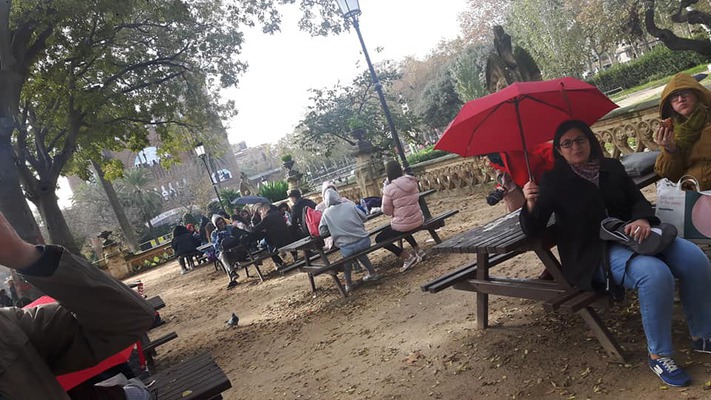2nd Day Activity (20/11/2018)
Starting at 9 o’clock in the morning, the students and teachers met in front of Col·legi Badalonès’s entrance and travelled by subway (L2 line) to Universitat, which stands 5 minutes away from the city center, Plaça Catalunya. Plaça Universitat sits on an interesting point of Barcelona, in the beginning of l’Eixample (long streets and gridded organization, part of an urban plan called Pla Cerdà), and the old part of the city or Ciutat Vella. We started walking down Tallers street to MACBA square, where the Museum of Contemporary Art Stands, skateboarders’ haven. We drifted into Raval, known before as “Barri Xinès”, or Chinese neighborhood, with almost 50% of its population coming from abroad. We walked down la Rambla del Raval, where we saw some famous sculptures of the Colombian artist Botero and headed for our next stop, the Juan Andrés Benítez agora, dedicated to the founder of the Catalan Association of Businesses for Gays and Lesbians who died in 2013 after being brutally beaten by a police patrol in the city. This space is managed by the Raval community and is a meeting point for friends and families to practice activities such as martial arts or to express their feelings through wall art, as we were able to see with the numerous graffiti, such as the one titled “Ravala’t” (let’s remember rebel·lar means to rebel in Catalan), dedicated to the the neighborhood’s fight against an urban speculation which can gobble up identities, a real problem in big cities in general and especially in Barcelona. We were also able to observe several pieces of wall art dedicated to refugees and immigrants living in Barcelona, giving us insight on the importance diversity and integration have for the city.
After this, we strolled towards les Rambles, which once separated the walled part of the old city of Barcelona from the fields which are now Raval, and from there walked through the Gothic quarter towards Plaça Felip Neri, after losing some students who were on the lookout for xurros! In Plaça Felip Neri we were able to see a part of the crudest side of Catalan and Barcelonan history drawn on the walls of the church, close to which forty-two people died, most of them children, during the bombings the city suffered in the Spanish Civil War. The next stop was the Cathedral of Barcelona. Some of us visited it and others went to take pictures of a well-known mural close by. As lunch time was getting close, we headed through Born and the Arc de Triomf towards Ciutadella Park, where we had lunch.
The second part of the day consisted in a visit to the History Museum of the City of Barcelona, where we were able to see parts of what was Barcino, the Roman walled city of Barcelona, strategic point for the Roman Empire in the Mediterranean and in the Iberian Peninsula. We finally headed back home, after walking through Plaça Sant Jaume, where the city hall and the Palau de la Generalitat (office of presidency of the Catalan autonomous government) are, les rambles and through Plaça Catalunya.
We finally headed back home, after walking through Plaça Sant Jaume, where the city hall and the Palau de la Generalitat (office of presidency of the Catalan autonomous government) are, les rambles and through Plaça Catalunya.